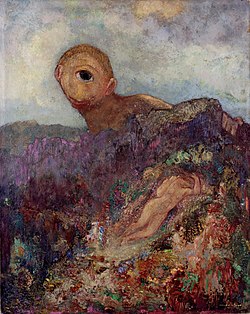Postimpresionismus
Postimpresionismus (též poimpresionismus, pozdní impresionismus) není jednotný umělecký proud, jedná se o různé umělecké projevy na přelomu 19. a 20. století, které se rozvíjely hlavně na území západní Evropy, převážně ve Francii. Termín postimpresionismus poprvé použil umělecký kritik Roger Fry v roce 1910 v souvislosti s výstavou moderních francouzských malířů v Londýně, která byla nazvána Manet a postimpresionisté. [1]
Zrakový dojem a přesnost nebyly tak důležité jak u impresionismu, důraz byl kladen na metodu, pocity a expresivitu. Hlavními představiteli tohoto směru byli Paul Cézanne, Paul Gauguin, Vincent van Gogh, Henri de Toulouse-Lautrec, Georges Seurat či Pierre Bonnard. Mezi umělkyněmi patří přední místo Suzanne Valadonové a Emily Carrové.[1]
Tento směr zahrnuje uměleckou skupinu Nabis, dále hnutí neoimpresionismu (pointilismus a divizionismus) cloisonismu, symbolismu a syntetismu.
Galerie
- Paul Cézanne (1839–1906)
- Odilon Redon (1840–1916)
- Paul Gauguin (1848–1903)
- Vincent van Gogh (1853–1890)
- Georges Seurat (1859–1891)
- Henri de Toulouse-Lautrec (1864–1901)
- Paul Sérusier (1864–1927)
- Henri Moret (1856–1913)
- Hvězdná noc, Vincent van Gogh
- Oslava nezávislosti, Henri Rousseau
Odkazy
Reference
Externí odkazy
 Obrázky, zvuky či videa k tématu Postimpresionismus na Wikimedia Commons
Obrázky, zvuky či videa k tématu Postimpresionismus na Wikimedia Commons
Média použitá na této stránce
Autor: unknown, Licence:
In 1889, after suffering a severe hallucinatory seizure, Van Gogh committed himself to an asylum near Saint-Rémy. While walking through the town that fall, he was impressed by the sight of men repairing a road beneath immense plane trees. Rushing to capture the yellowing leaves, he painted this composition on an unusual cloth with a pattern of small red diamonds, visible in the picture’s many unpainted areas. “In spite of the cold,” he wrote to his brother, “I have gone on working outside till now, and I think it is doing me good and the work too.” After painting this composition directly from nature, Van Gogh used it to produce a second version in the studio known as The Road Menders at Saint-Rémy. Painted on a traditional canvas covered by a ground layer, the second version is more restrained, the explosive yellows balanced by larger areas of cool color.[1]
Avec ce tableau, Henri Rousseau commémore le centenaire de la Première République française de 1792]



















